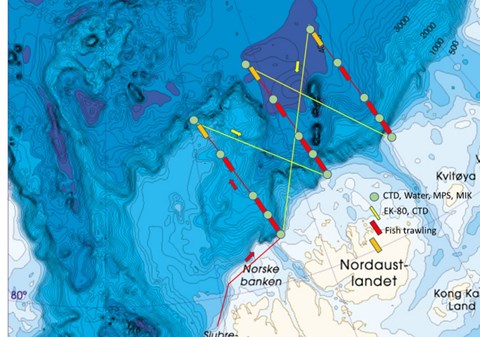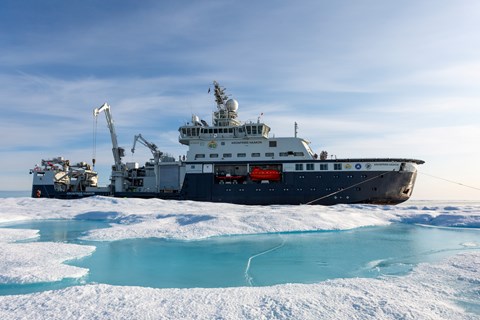Call for an Early Career Scientist – Arctic Ocean Research Cruise 2023
This call is closed.
The Norwegian Polar Institute will organise an expedition in conjunction with the upcoming Norwegian Chairship of the Arctic Council. The cruise will start in Longyearbyen, Svalbard, on 19 August and end in Longyearbyen, Svalbard, on 29 August 2023.
Geographical focus area
The surface temperature in the Arctic Ocean has increased three times the global average, and the Arctic Ocean is in a fast transition towards ice-free conditions with the ongoing climate change. Svalbard, the northern Barents Sea and the Nansen Basin are one of the areas that are experiencing the largest changes. The Arctic Ocean Research Cruise 2023 will focus on the area north of Svalbard.
Research topics
Students at the Master- or PhD level from the Arctic countries and communities are invited to participate in this cruise. In total, it is anticipated to be 12-15 students. On board, the Early Career scientists will be working with scientists and their research in the fields of physical and biological oceanography, sea ice, aquatic ecosystem, microplastics and contaminants. As an Early Career scientist, you will participate in the data acquisition and have the opportunity to use the collected material and data in your research.
The cruise will target the area north of Svalbard with three transects from the shelf down the slope of the Nansen Basin (Figure 1). CTD stations with water sampling, chlorophyll measurements and zooplankton sampling will be performed at five stations along each transect. Pelagic trawling will be done in and around the mesopelagic layer at 300-600 m depth at four trawl stations per transect, and fish distribution will be monitored by EK80 hydroacoustic. At the end of each transect, there will be short ice stations with measurements of the thickness of the meltwater layer below the sea ice, turbulence, and fluorescence. Ice cores will be taken to determine ice thickness, structure and the layer of ice algae. Samples of ice algae and phytoplankton will be taken for taxonomic identification in the microscope. A GoPro camera will be used for registration of under-ice structures, meltwater layer and ice-associated flora and fauna. Between trawling transects, there will be EK80 transects with CTD stations. The density of the CTD station needs to be sufficient to map the extent and oceanographic properties of the Atlantic Water Boundary Current along the continental slope north of Svalbard.

The knowledge from this and following cruises in the Arctic Ocean are expected to substantially increase our understanding of physical and biological drivers and processes in this area of the Central Arctic Ocean (CAO). The ice-covered CAO, with depths down to 4000 m, is one of the least-known areas on our planet. This cruise will focus on ecological aspects, mainly fish and zooplankton, in and around the Deep Scattering Layer (DSL). This is a horizontal zone with living organisms (zooplankton and fish) detected as hydroacoustic backscatter by echosounder at 200-1000 m depth in the world’s oceans, and it has also been detected at 300-600 m depth in the CAO. The fish fauna in and below this layer extends into the CAO but is poorly known.
Outcome
Data and information from this cruise and following cruises into the Central Arctic Ocean will contribute to a specific working group in the Arctic Council. This knowledge is also important for the ongoing management work conducted under the ICES-PICES-PAME Working Group on Integrated Ecosystem Assessment for the Central Arctic Ocean (WGICA), and for continued work under the Circumpolar Biodiversity Monitoring Program (CBMP) of the Arctic Council’s Conservation of Arctic Flora and Fauna (CAFF), see the Arctic Council work packages here. The State of the Arctic Marine Biodiversity Report (SAMBR 2017) aims to be updated in the near future.
Participation
Early Career Scientists (PhD-students or Master's students) within a Swedish university or research institute are invited to apply for participation on board Norwegian research icebreaker RV Kronprins Haakon.
Norwegian Polar Institute will cover travel and participation costs, and living costs onboard RV Kronprins Haakon. Salary or per diem will not be covered. Participants will also, after the cruise, be invited to participate in conferences, and seminars to share their experiences and knowledge.
The Early Career participation will be an educational initiative where you will get experience from different scientific projects, networking and training on scientific communication. The cruise will include an interactive series of talks and discussions on Arctic changes, issues strategies and policies.
Assessment and Selection
Submitted applications will be assessed according to the following criteria: scientific/study merits, the relevance your described project/current studies have to the defined research topic onboard and how the project and motivation describe the applicability to further work or your scientific career.
Contact
If you have any questions, please contact
Cecilia Lund
Senior Research officer, Swedish Polar Research Secretariat
cecilia.lund@polar.se, +46 73-644 58 08


